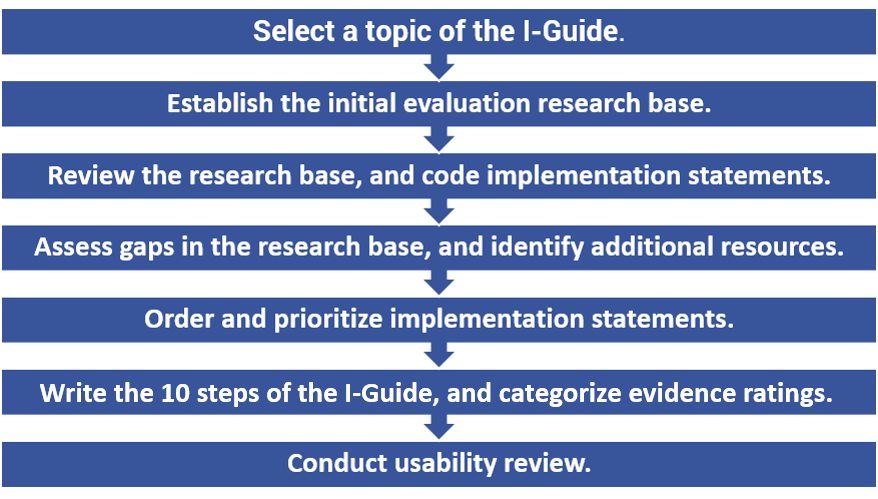Creation of I-Guides
- Creating an I-Guide
-
The I-Guide creation process is a systematic research review and synthesis of the factors that are likely to affect the implementation of evidence-based programs and practices in a particular topic area and the translation of them to comprehensive, action-oriented guidance. It includes the following seven steps:

- Select a Topic of the I-Guide. The first step of the I-Guide creation is to identify a topic that has a comprehensive set of evidence-based resources. Research staff at Development Services Group, Inc. (DSG)*, review the practices with youth populations on CrimeSolutions.gov that have accompanying literature reviews on MPG, as well as associated programs in the program database. It is anticipated that there will eventually be I-Guides for all topics that meet these criteria, but owing to limited resources they will be posted incrementally.
- Establish the Initial Evaluation Research Base. First, research from the MPG program database, MPG literature reviews, and juvenile justice practices on CrimeSolutions.gov is identified and logged, and the original sources are retrieved. This step includes all topic-related outcome evaluations that have been catalogued as part of the screening and review process for MPG and CrimeSolutions.gov.
- Review the Research Base, and Code Implementation Statements. DSG research staff review this entire research base and code “implementation statements” found in each of the studies. Implementation statements are pieces of information from the research base that relate to the implementation topics covered by the 10 steps of the MPG I-Guides. All the identified implementation statements from the research are then entered into the Implementation Research Coding Instrument. The originating source of evidence for each statement is also entered into the coding instrument for later categorization of evidence strength (see step 5).
- Assess Gaps in the Research Base, and Identify Additional Resources. Once the initial instrument coding is completed, gaps in the instrument show where there are no corresponding statements about 1 (or more) of the 10 steps. Additional research is then identified to cover the gaps. Additional research is identified through targeted searches of the same databases used to find programs for CrimeSolutions.gov and MPG, such as journals, publications, research organizations, and government agencies. This new research is then reviewed and coded to the instrument, following the same procedures in step 3.
- Order and Prioritize Implementation Statements. For each of the 10 steps, all implementation statements coded to that step are organized and prioritized. Implementation statements from outcome evaluations featured on MPG are prioritized before information from other types of research. In addition, given the wide range of information on implementation, not all of the research coded to the Implementation Research Coding Instrument is included in an I-Guide. Information is translated into action-oriented guidance if a) it is mentioned across various studies, b) it was found to be critical in the implementation of program, and c) it can be translated into helpful guidance for users.
- Write the 10 Steps of the I-Guide, and Categorize Evidence Ratings. The prioritized implementation statements are then translated into the action-oriented, user-friendly guidance and recommendations, which are the central feature of each I-Guide. The action-oriented recommendations within each of the 10 steps are then assigned to one of the four levels of evidence. For example, recommendations receive the highest levels of evidence if they are based on information from program evaluations that meet the minimum study design standards to be included on MPG. Recommendations receive the lowest levels of evidence if they are based on research that does not meet the minimum standards to be reviewed for the MPG, such as case studies or other types of qualitative research. Specific examples from MPG programs are then added to illustrate implementation of evidence-based programs relating to a specific topic.
- Conduct Usability Review. Before it is finalized, the I-Guide is reviewed internally and sent to outside reviewers, who represent the target audience of the I-Guide, for feedback and comments on the clarity of information provided about the 10 steps. This step is not to identify new information, but instead to refine the language and presentation of the information. Based on feedback, the language in the I-Guide is revised to ensure that the most practical and useful guidance for users is included, without inundating users with too much information.
*DSG staff includes Research Assistants with oversight from Senior Researchers. See https://www.ojjdp.gov/mpg/Home/About





